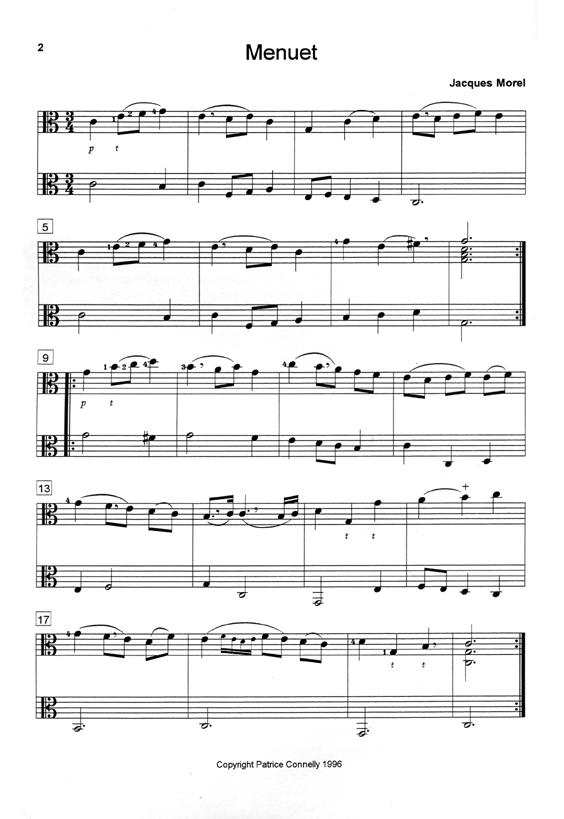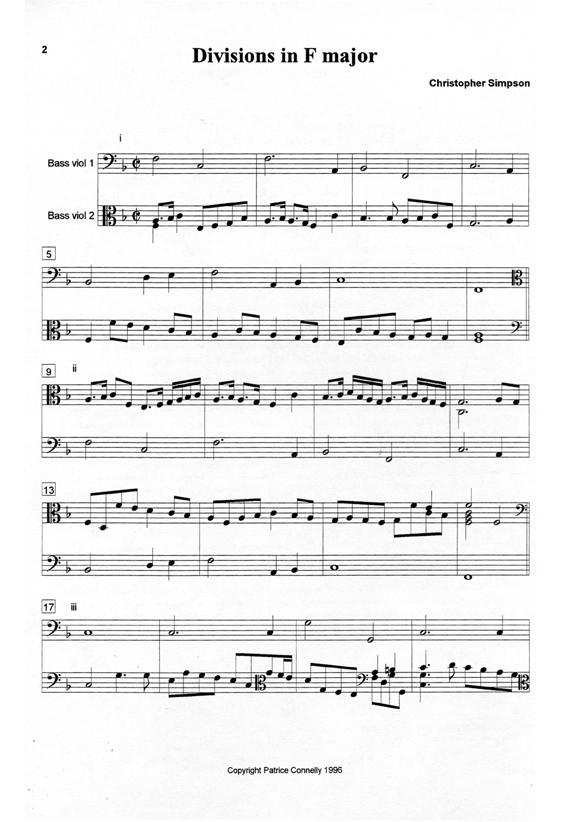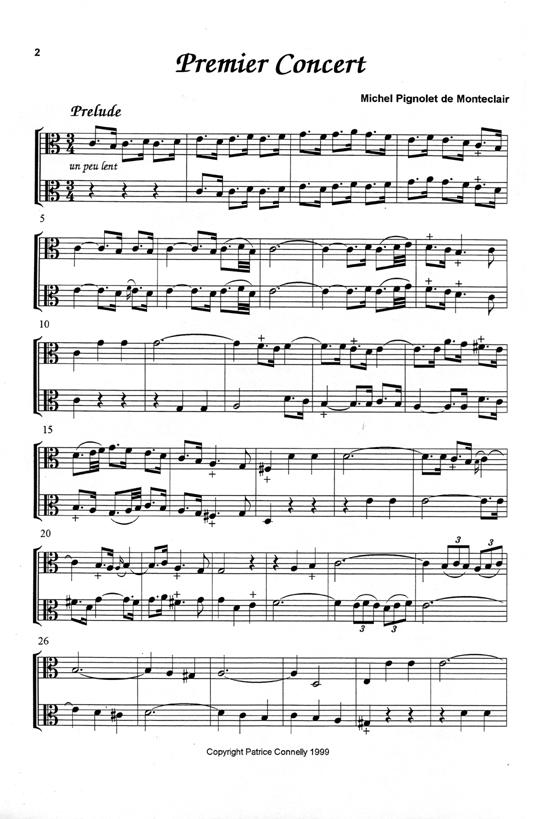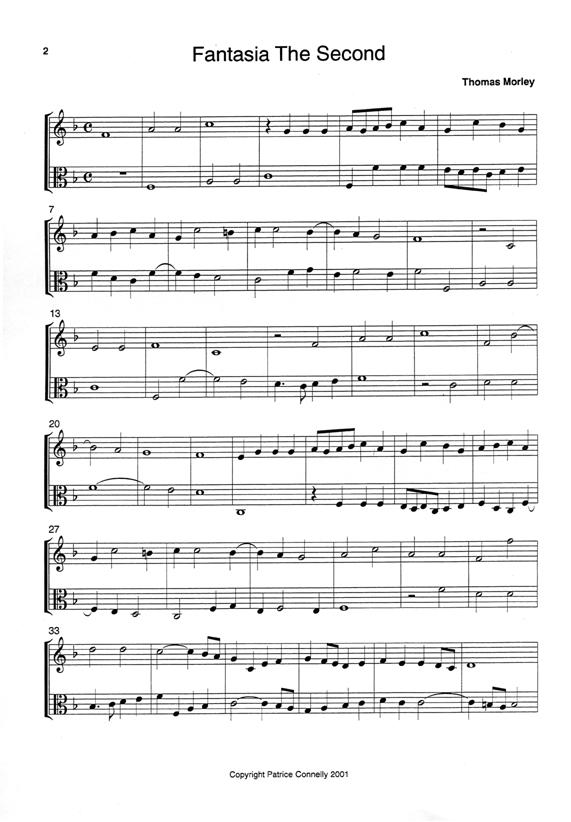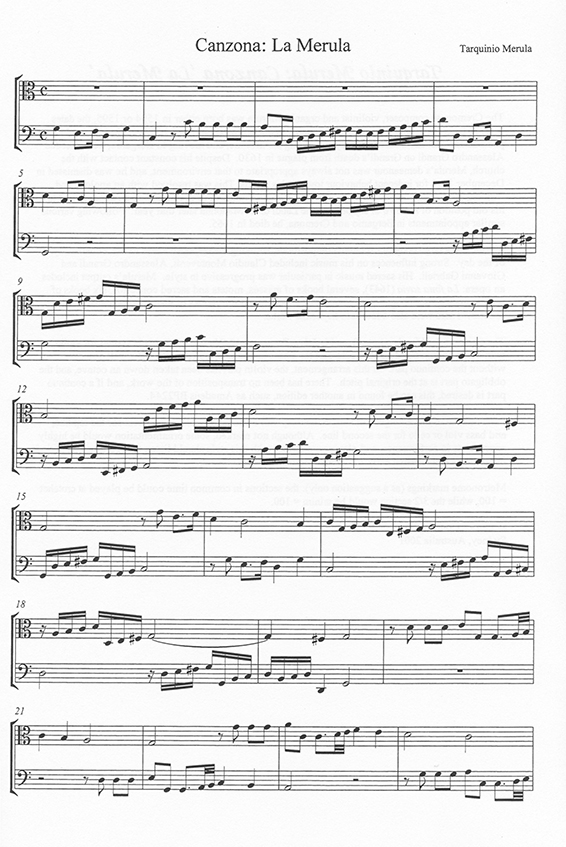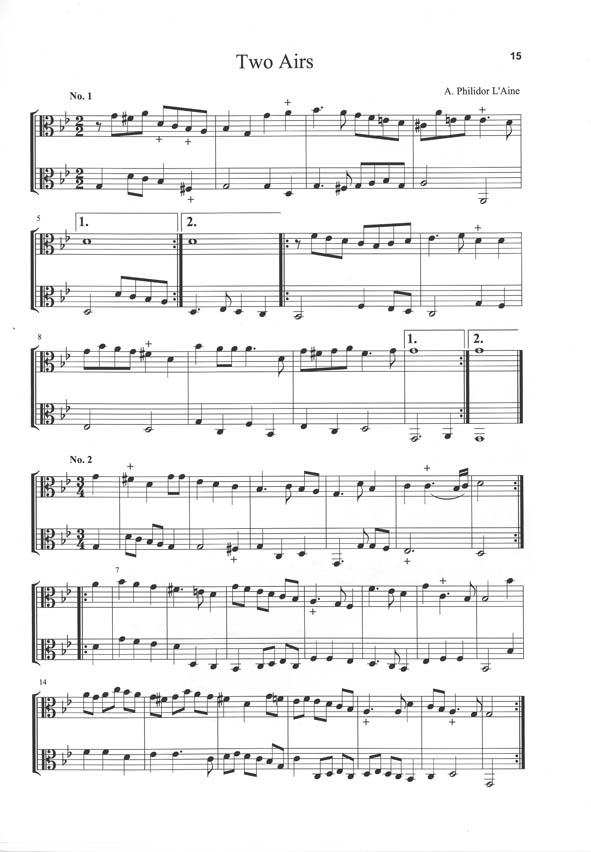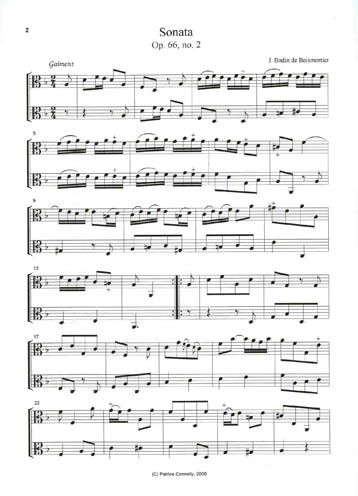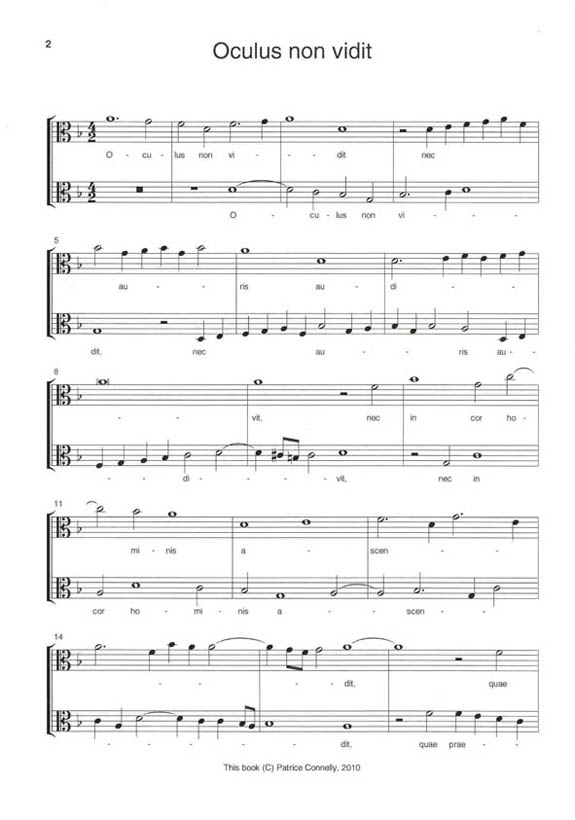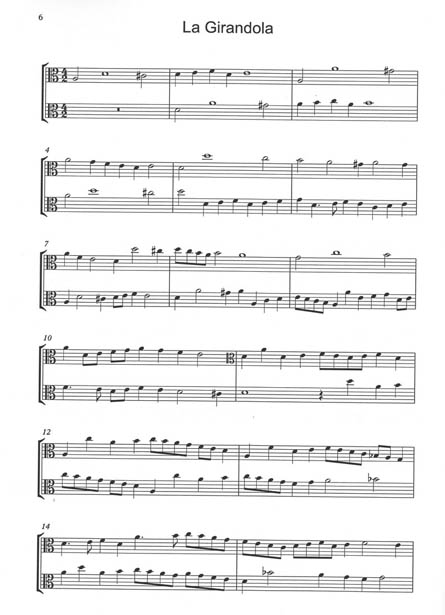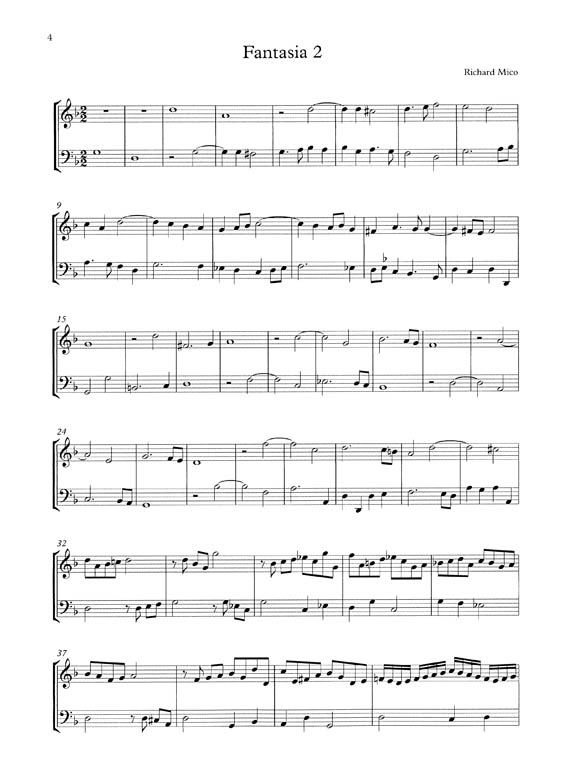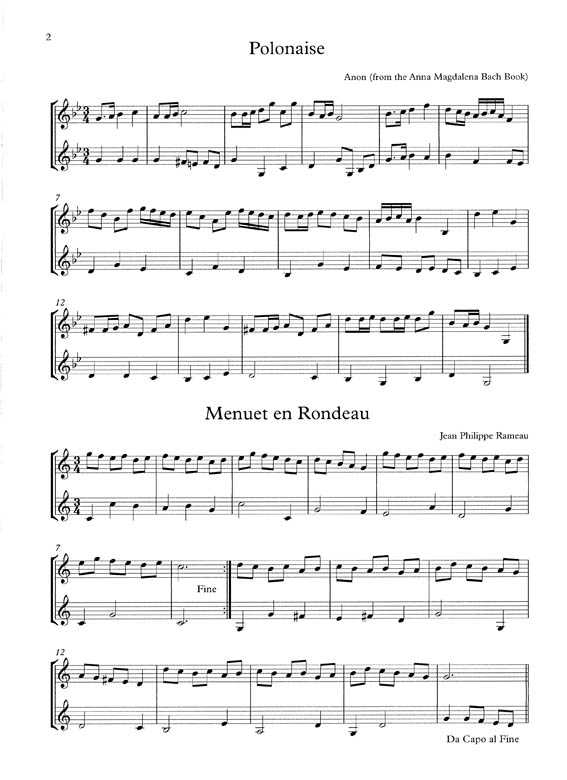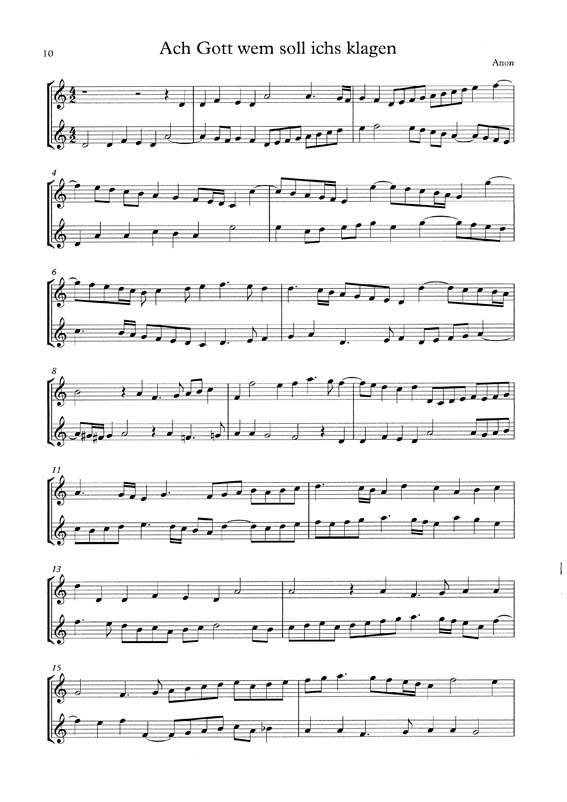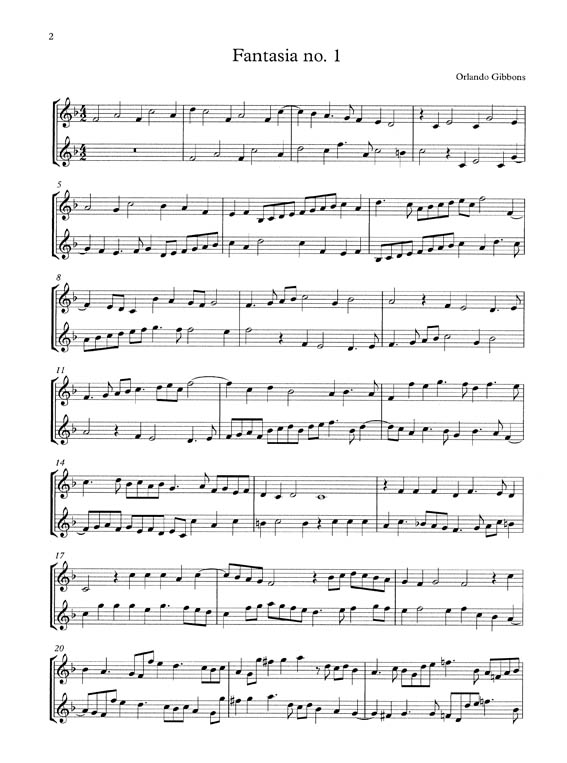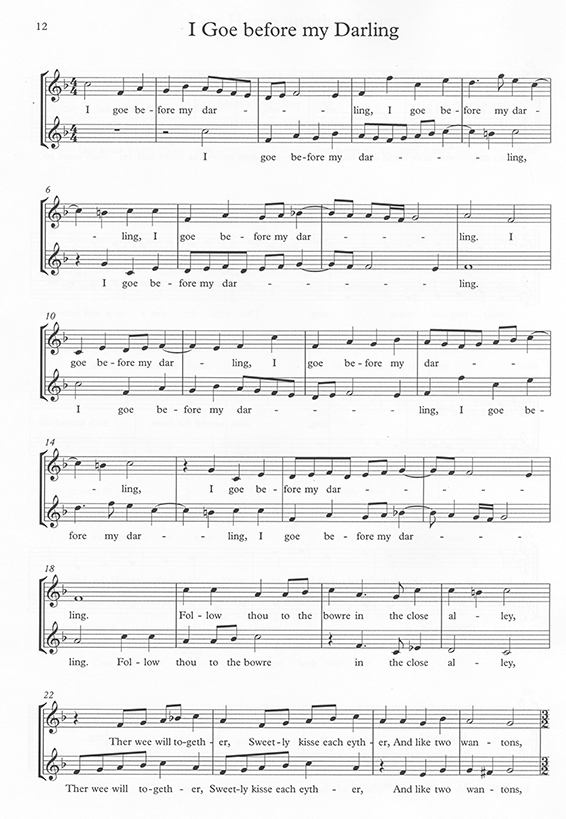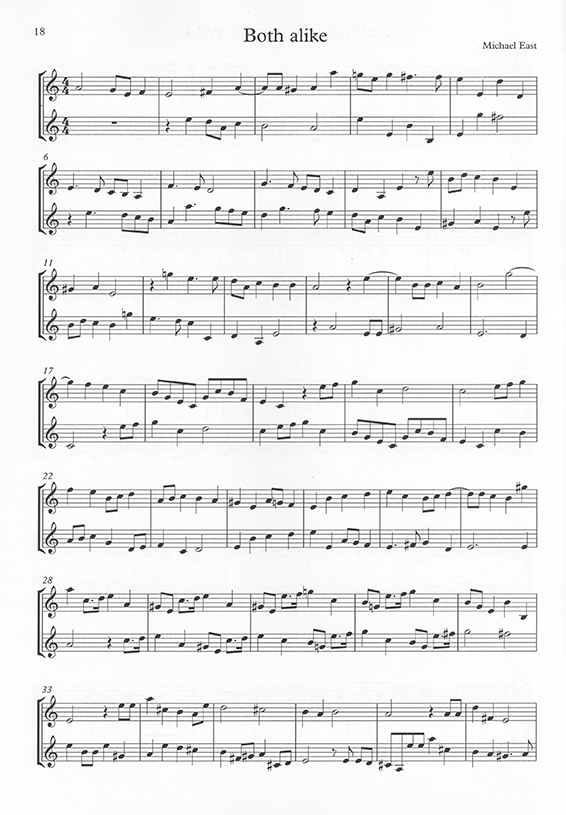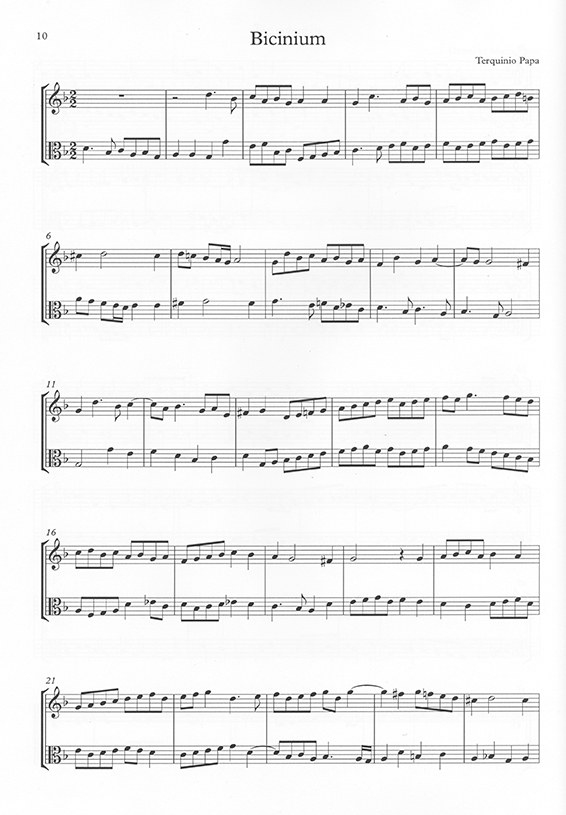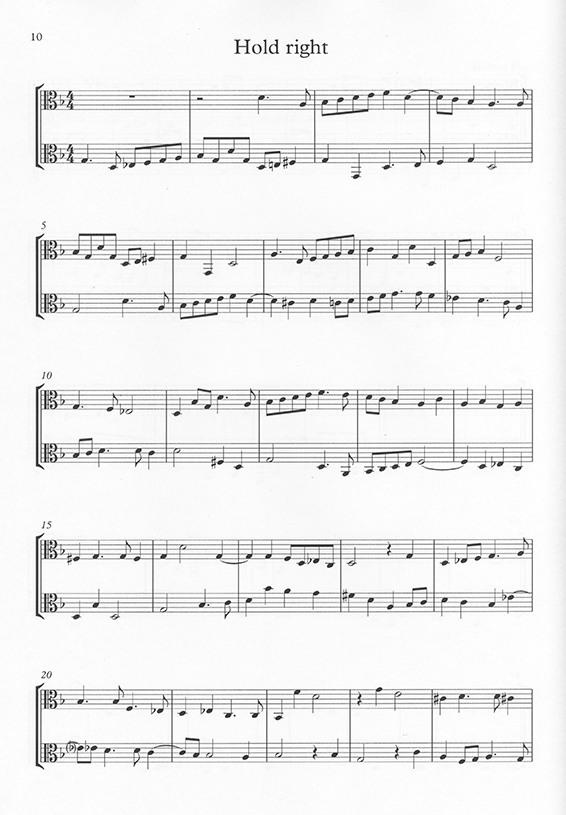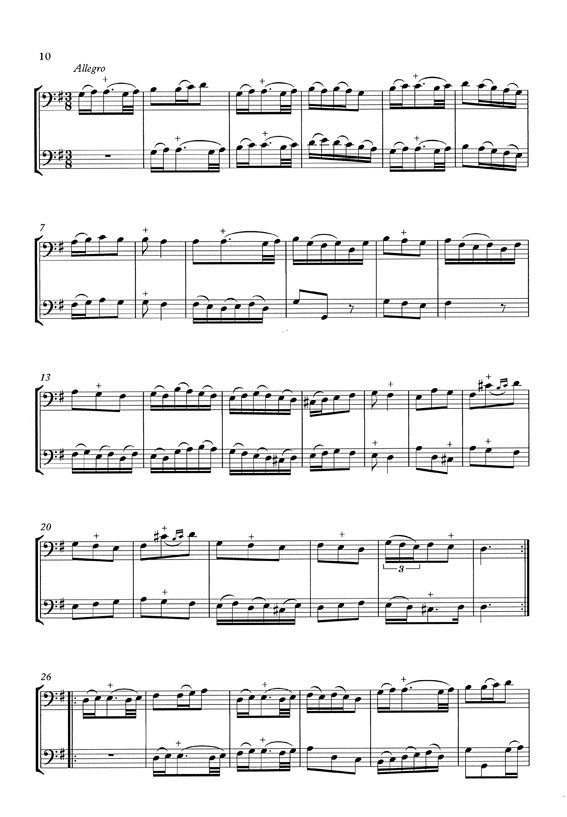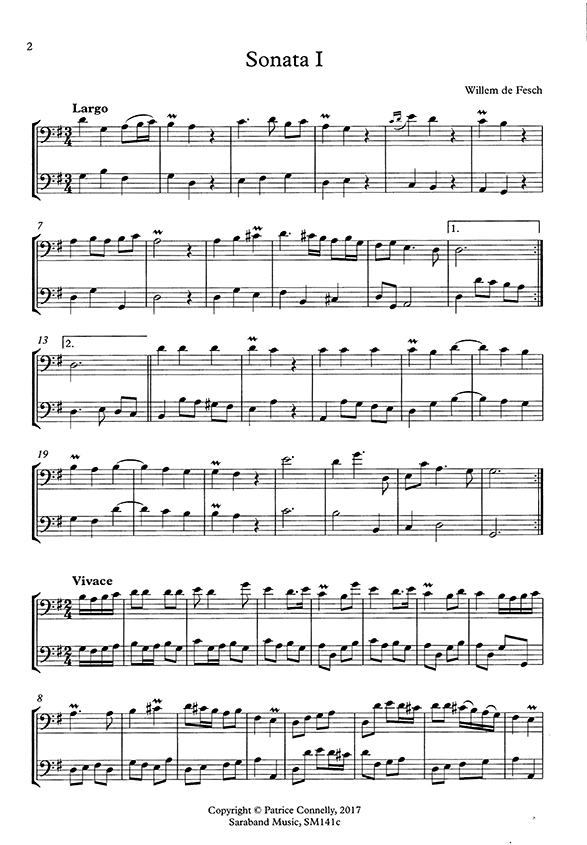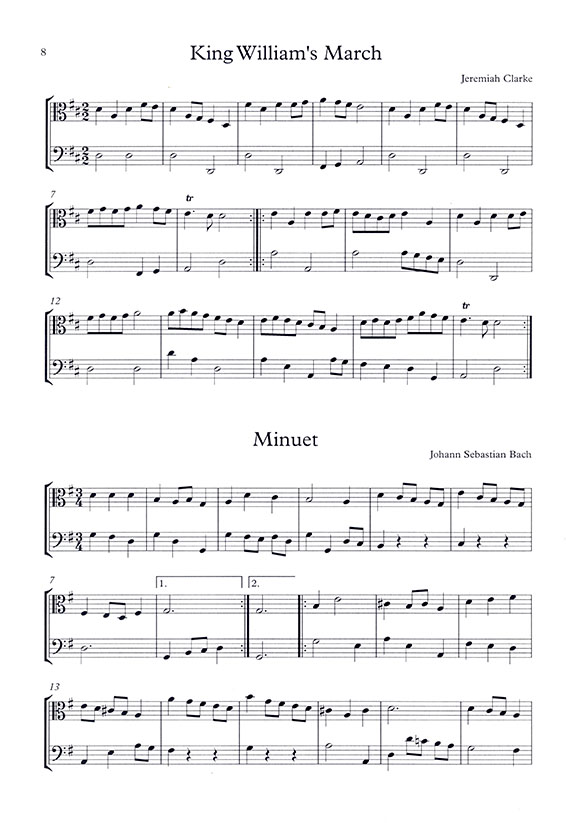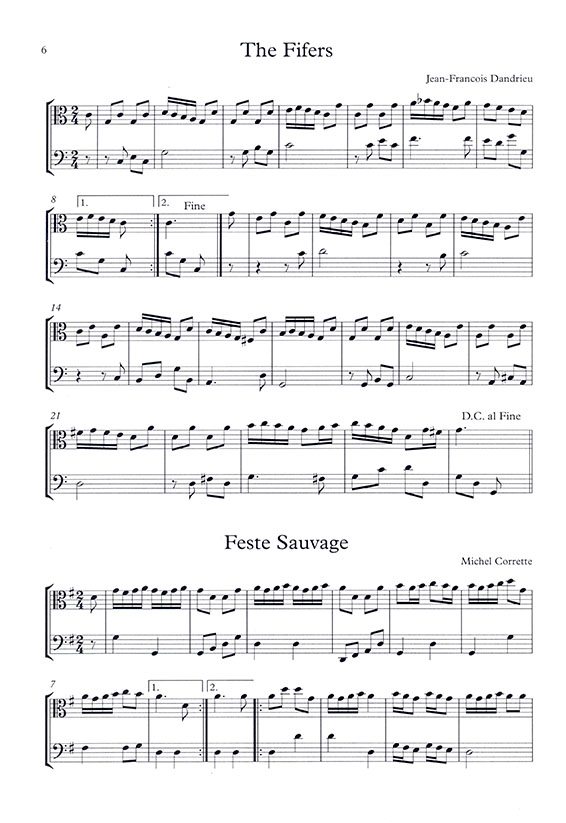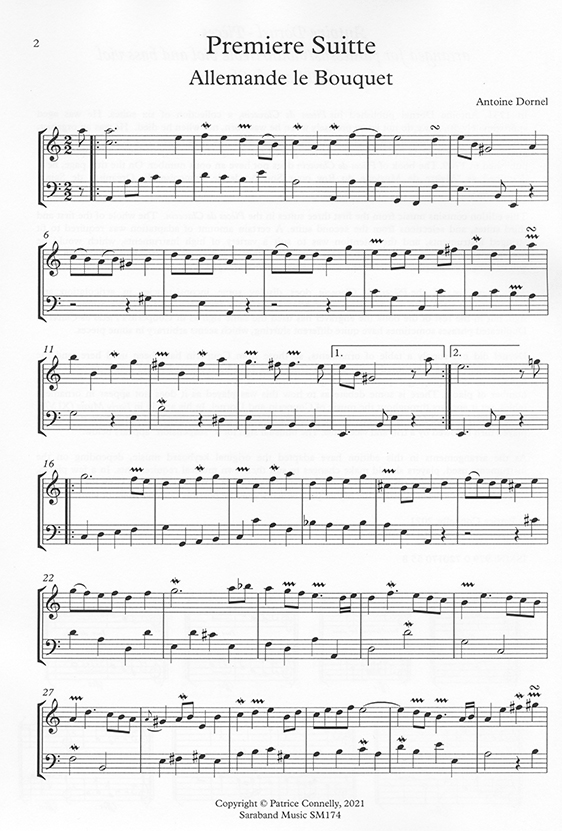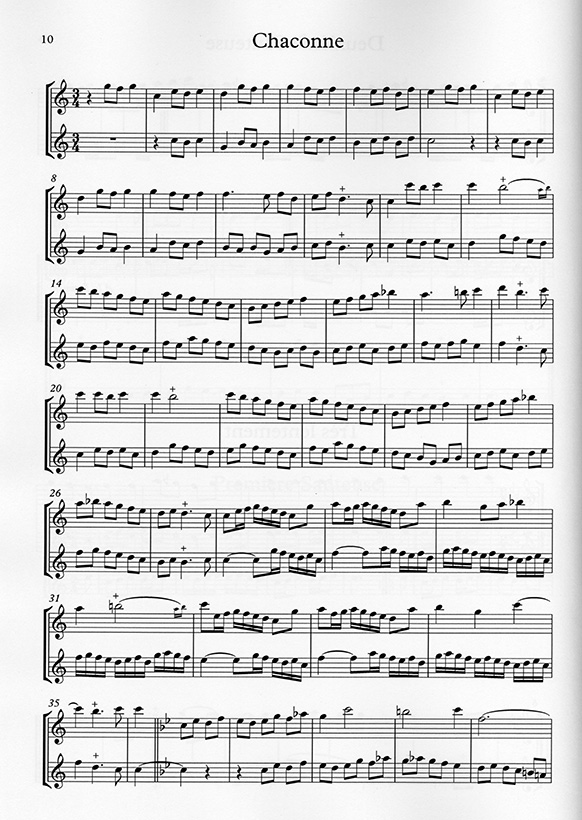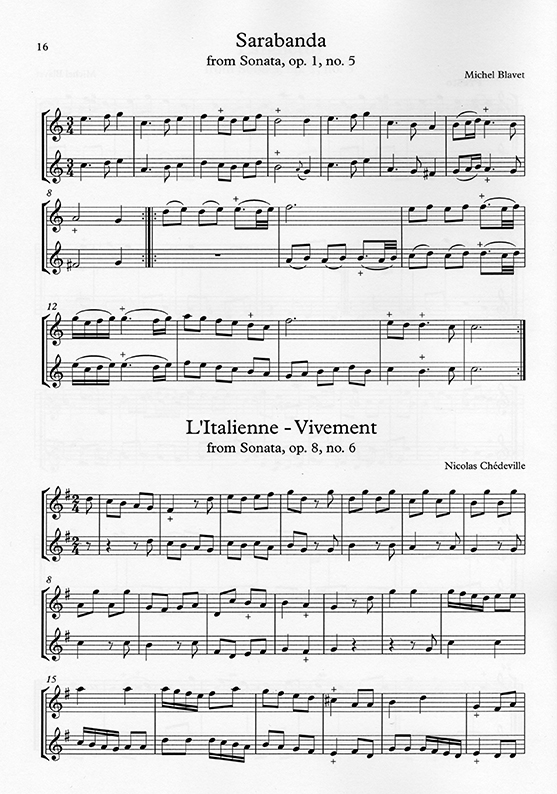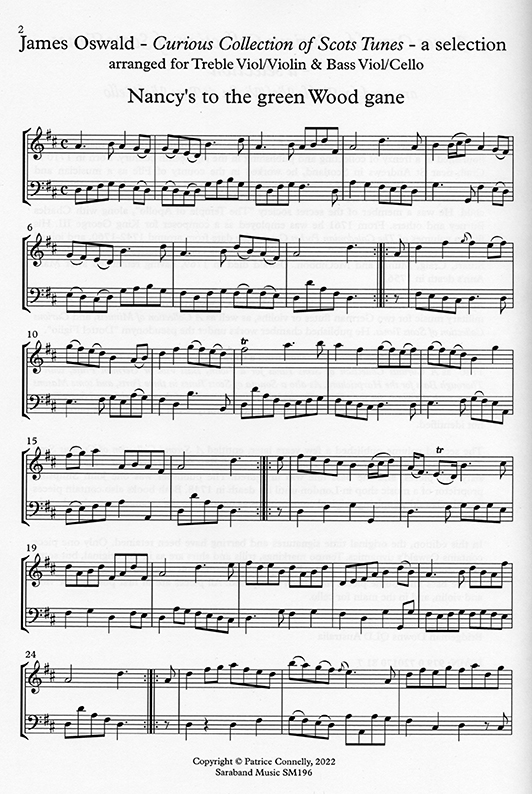Viol Duo Editions

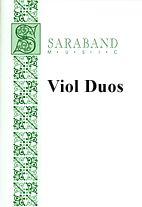
Sample pages have been provided from each edition. These are copyright, and are not necessarily indicative of the standard of difficulty of the whole edition.
Some audio samples have been added to this page.
Prices on this page do not include Australian GST. Australian residents please add 10%.
These two collections contain English music. Vol. 1 has works by Thomas Morley, William White and Orlando Gibbons, while Vol. 2 contains music by Morley, Anon, Corkine and Gibbons. Most of the pieces were originally written for viols, but there are a couple of vocal transcriptions as well. Intermediate to advanced level. Two scores. Attractive music, good for teaching or enjoying. Audio sample is a Gibbons Fantasia.
This companion volume to SM1 & 2 contains French music by Boismortier, Hugard, Morel and Philidor. The Morel Menuet is quite easy, but the rest of the book is slightly more challenging. There are two complete sonatas (op. 66) by Boismortier. Two scores.
A highly virtuosic set of divisions for two basses, exciting and tuneful music by the master of the Division genre in England. Score and parts.
Originally for two flutes, this charming suite has been transposed and put into alto clefs to suit viols. It is quite a substantial suite, and suitable for teaching or performance. It works with two tenors or two basses or one of each. Two scores
Note
SM30a is the same music for 2 cellos, and in bass clefs.
A collection of 11 pieces of varying standards for a treble and a tenor viol. Composers include Morley, Coprario, Nenna, Boismortier, Barsanti, Lassus, Christopher Gibbons and others. Two scores.
This duo was originally for violin, cello and b.c., but it works wonderfully as a duo for two bass viols, or viola and cello. Challenging, but not so virtuosic as to be impossible. Good concert piece. Score and parts.
This collection of 13 pieces by Certon, Purcell, Gastoldi, Henry VIII, Anon, Handel, Josquin, Monteclair and Boismortier contains music of varying standards, suitable for teaching. Some very simple pieces will be suitable for lower intermediates, while more experienced players will find the Boismortier and Monteclair more challenging. Truly a book for all standards! Two scores.
By popular demand, another collection of duets for tenor viols. This one is A Renaissance and Baroque Miscellany, and has pieces by Anon, Ste Colombe, Lassus, Monteclair, John Withy, Morley, Philidor and Hume. One or two simple pieces, but this time some more challenging works too. Some of these are suitable for two violas. Two scores.
More advanced tenor viol players will welcome this French music, which has been transposed up a fourth from the original version for 2 cellos/bass viols. There are some easy movements, but these are pieces which can be enjoyed or performed. There is plenty to learn from their use in classes and workshops. Upper intermediate to advanced. Not suitable for violas. Two scores.
More for two tenors - intermediate to advanced. These lovely duets by Lassus will be perfect for students and very suitable for performance. This is a selection of ten.
This is a companion book to Natalie Dolmetsch's 1956 Hortus Musicus edition of Morley's 9 Fantasias, in their original scoring for 2 trebles or treble & tenor viols. In this book, the same pieces are transposed 1-2 times to fit different ranges, which allows many more people to play them. Single score. Il Grillo is on the audio sample.
Mico's worthy Fantasias have been published before, but not in an edition like this. Firstly, the original TrB fantasias have been carefully edited from the original, as was the Anonymous TrTr fantasia from the same ms. Versions for two basses have been added, so that more people can play this music. The score is for the bass player, while a part has been constructed with the originals and transpositions for the other player. Score & part.
Doesn't every teacher or beginner need some easy duets at times? This book has pieces by Telemann, Rameau, Hook, Mouret and others. Lots of dances and short movements from sonatas. They're tuneful and cover easy to intermediate. 2 scores
Audio sample is the Purcell Hornpipe.
The same book as SM92, but transposed to fit bass clef instruments (SM92a)
The same book as SM92, but transposed to fit alto clef instruments (SM92b)
These duets are for advanced players. They are much more challenging works, but good for study, performance and teaching. Some are quite early Renaissance works.
Same music as SM93, transposed for bass instruments, using bass clef. 2 scores
Same music as SM93, transposed for tenor instruments, using alto clef. 2 scores
Gibbons was a master composer. This beautiful fantasias are a joy and are one of the cornerstones of the English Renaissance duo repertoire for viols. 2 scores
Why let the high instruments have all the fun. Now bass instruments can play the same lovely repertoire.
No tenor book is planned as a few of these already appear in the Duets for Tenor Viols series above.
More Morley is always welcome. This edition of four fantasias and four canzonets compliments SM77 9 Fantasias. 2 scores. Audio is I goe before my Darling.
This collection includes music by Anon, Corkine, Dowland, East, Jones, Locke, Morley, Rosseter and William White. Texts are included for the vocal works so they could be performed with singer and viol as well as instrumentally. 2 scores. Audio is Both alike
At last a followup edition to SM39, pairing treble and tenor viols (or violin and viola). Music by Banchieri, Galilei, Gardano, Licino, Lupacchino, Tasso and others. 2 scores. Audio is Terquinio Papa's Bicinium
Originally for bass viols, these popular duos have now been transposed for two tenor viols. 2 scores. Audio is Hold right
Edited by Patrice Connelly
These are six interesting sonatas which date from 1739, and were republished in 1765. Originally for two flutes/violins/pardessus, they work nicely for two bass viols, extending the French viol duet repertoire. I even prefer these pieces to Boismortier's many duos. Critical/performing edition with commentary relating to the violin edition, and an extensive intro. 2 scores. For audio, go to the bowed strings page.
Dutch composer Willem de Fesch was an almost exact contemporary of Handel. This collection of 6 sonatas was written for two German flutes or violins, and first published in England in 1739. Saraband has published the original version, plus three books of transpositions: SM141a for treble viol/violin in first position; SM141b for tenor viol or viola, and SM141c for bass viol or cello. It is also possible to play these duets using SM141a and c on violin and cello or treble and bass viols as the keys are the same.
Twenty five easy pieces, roughly graded, for tenor and bass viol duet. A lot of the pieces have been arranged from keyboard music, and cover baroque and classical periods. Plenty of minuets, airs and more. Bach, Handel, Krieger, Playford, Couperin, Purcell and more, from England, Italy, France, Germany and Austria. All in first position, but there are some technical challenges to keep things lively. Two scores. Audio is King William's March.
Seventeen pieces from England, France, Germany, Austria and Flanders grace this volume of slightly harder pieces for tenor and bass viol duet. Bach, Dandrieu, Corrette, Dolle, Handel, Haydn, Hook, Mozart, Playford, Rameau and others. In this book, the tenor part has to shift to a top D (not too hard!) and the music is a touch more challenging. Plenty of dances, and a couple of Playford folky tunes, plus a lovely Benedictus by Renaissance composer Josquin des Prez. Two scores. Audio is The Fifers.
The first three suites of Antoine Dornel's Pièces de Clavecin have been arranged for high and low instrument. The top part can be played on pardessus de viole or violin, or treble viol which goes just past the top fret. The lower part is best suited to bass viol, though could be played on cello. Mostly dances and rondeaux, and plenty of ornamentation. The preface shows some of Couperin's ornament table so that you can interpret the various ornaments. Audio is La Badine Rondeau.
This edition comes with variants for treble, tenor and bass viols, but can be played on any instruments that fit. You can play equal instruments, or high and low if you use SM179 and 179b together, or SM179a and 179c together. The music is not unlike Boismortier, and consists mostly of dances, with a few slow movements. There are easy pieces as well as more challenging.
Audio is Naudot's Quatrieme Babiole, first movement.
Here's an edition of 23 French 18th century pieces which can be played on 2 violins or 2 treble viols or any other high instrument which fits the violin's range. Quite a few pieces do not go below middle C in at least one of the parts, so oboe or flute are also possible. The treble viol has a few shifts above the frets which is great for extending technique!! There are easy as well as more difficult pieces.
Music is by Boismortier, Blavet, Corrette, Chedeville and Naudot. It's mostly movements from sonatas, and lots of dances - minuets, sarabands and a couple of gigues. Two scores.
Audio is Chedeville's L'Italienne.
James Oswald was a prolific collector of traditional Scots tunes at a time when such a phenomenon was all the fashion. He published two books entitled Curious Collection of Scots Tunes in the early 1740s. Twenty of these pieces have been arranged in this edition for treble and bass viol duet or violin and cello duet. Intermediate to advanced standard, though some pieces have an easy bass line. Two scores.
Edited by Michael and Edith Kimbell, this meticulously produced edition is arranged for tenor and bass viols. The text is included so one line could be sung. The score is spiral bound and a separate tenor part provided. This and its companion book are a wonderful source of duets for viols or voice and viol.


